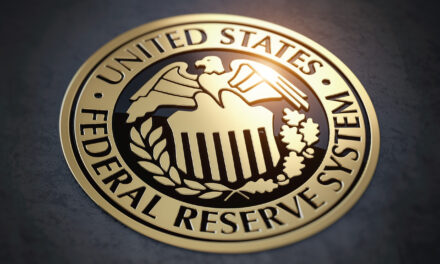“We’ll take inflation if necessary, but we can’t take unemployment.” – Richard Nixon
YOUGHAL, IRELAND — Today, we come bearing glad tidings.
We’ve seen how both Trump and Warren, the Federal Reserve, Congress, Krugman, Summers, the powers that be and all the ships at sea are committed to inflating our way out of the debt trap.
Just yesterday, Jerome Powell, top honcho at the Fed, reaffirmed the bank’s readiness to pitch in as needed.
The Financial Times reports:
The Federal Reserve will soon resume purchases of short-term U.S. Treasury bonds to expand its balance sheet in hopes of preventing a repeat of the recent disruption in overnight “repo” markets, chairman Jay Powell said on Tuesday.
Well, the good news is that if inflation is what they want, inflation is what they’ll get. But not necessarily the tame, friendly, housebroken inflation they are hoping for.
The monetary inflation that the Fed is pushing now will be followed by fiscal inflation (bigger deficits).
Angry in Debt
Mr. Trump is on the case already, with $1 trillion deficits even in a boom. Ms. Warren aims to push even harder when she gets her turn to foul the economy.
Colleague Dan Denning opines:
In the most recent CBO (Congressional Budget Office) 10-year forecast, it reckons there will be $12.2 trillion in new debt between now and 2029. That’s an average annual debt-to-GDP ratio of 4.7% (vs. 2.9% for the previous 50 years).
If it grows that fast — and no faster — debt held by the public (retirees, pensioners) will be 95% of GDP by 2029. In other words, the American public are going to be holding the bag … leaving the former middle class angry, indebted, and hopeless.
The rich got the money, alright. It is now comfortably nestled in the prices of their stocks and bonds, which they are counting on their friends at the Fed to protect.
The middle classes got the debt — $22 trillion of “public” debt so far … rising to $40 trillion (our guess) by the end of the next decade.
But fiscal inflation will lead to consumer price inflation, the kind that lowers the value of money, increases the prices of goods and services, and wreaks havoc on just about everyone.
Dimes for Bonds
In the 1950s, we recall putting dimes in little booklets so that we could buy a U.S. savings bond. By the ’70s, though, we were laughing at ourselves.
How naïve and gullible we had been! The inflation of the ’70s practically wiped out the bond market. Those U.S. government savings bonds were a joke.
A few years from now, we expect to have another laugh. U.S. Treasury bonds, now so precious that they yield only 1.6%, will be cut in half … and cut in half again.
And — this is the good news — the value of $73 trillion in debt will fall back to reasonable levels. If the ratio of debt-to-GDP returns to the traditional 1.5 to 1 level we wrote about yesterday, about $41 trillion in debt will disappear.
In 1959, when we were saving dimes to buy Treasury bonds, consumer prices were rising about 1% per year. That rate continued for the next five years and was considered a fact of life.
But then, the facts of life changed; Lyndon B. Johnson’s Great Society and war in Vietnam began to show up as “inflation.”
By 1971, prices were rising at a 6% annual rate. This was such a calamity that Richard Nixon imposed wage and price controls … and, incidentally, eliminated the gold backing for the dollar.
Did these measures work? Of course not. Inflation rates kept going up. By 1974, prices were shooting up at a 12% rate.
President Gerald Ford declared inflation “public enemy number one.” He came up with the Whip Inflation Now, or WIN, button … as if the public had anything to do with it.
By 1979, inflation hit 14%.
Problem Solved
As the dollar lost value, so did stocks and bonds. In February 1966, it took 27 ounces of gold to buy the Dow. By September 1980, it took only 1.5 ounces. In real terms, stocks had lost 94% of their value.
Bonds took a big hit too. The yield on the 10-year Treasury rose from 6% at the end of the ’60s to 14% by the end of the ’70s. Our $25 savings bond from 1960 was worth about eight bucks.
That is a big part of the reason that WWII-era debt became much less of a problem. Not only was the economy growing, inflation reduced the value of the debt itself.
Which is just what will happen in the next go-round with inflation. The debt problem will be solved.
What will a Treasury bond with a 1.6% coupon be worth in a world with a 10% Consumer Price Index (CPI)? You do the math; it won’t be much.
This will solve the problem of “wealth inequality” too. The rich will get their comeuppance. Come the inflation, their assets will all be chopped to pieces. And then, Ms. Warren will go to work on them, too, with hammer and tongs.
Leading Jackasses
So, you see, Dear Reader … the future is not all grim.
Yes, millions of people will lose their jobs and their wealth … their retirement incomes will be cut (the government will still pass out Social Security checks adjusted for inflation … but the adjustments will be too little, too late) … consumer price increases will leave the masses destitute and desperate … leading to even more absurd politics and policies …
But take heart; there’s an upside.
Excess debt will be eliminated … fake wealth will be destroyed … and people may come to see leading economists, Fed governors and policymakers for the jackasses they really are.
More to come …
Regards,
Bill
• This article was originally published by Bonner & Partners. You can learn more about Bill and Bill Bonner’s Diary right here.




